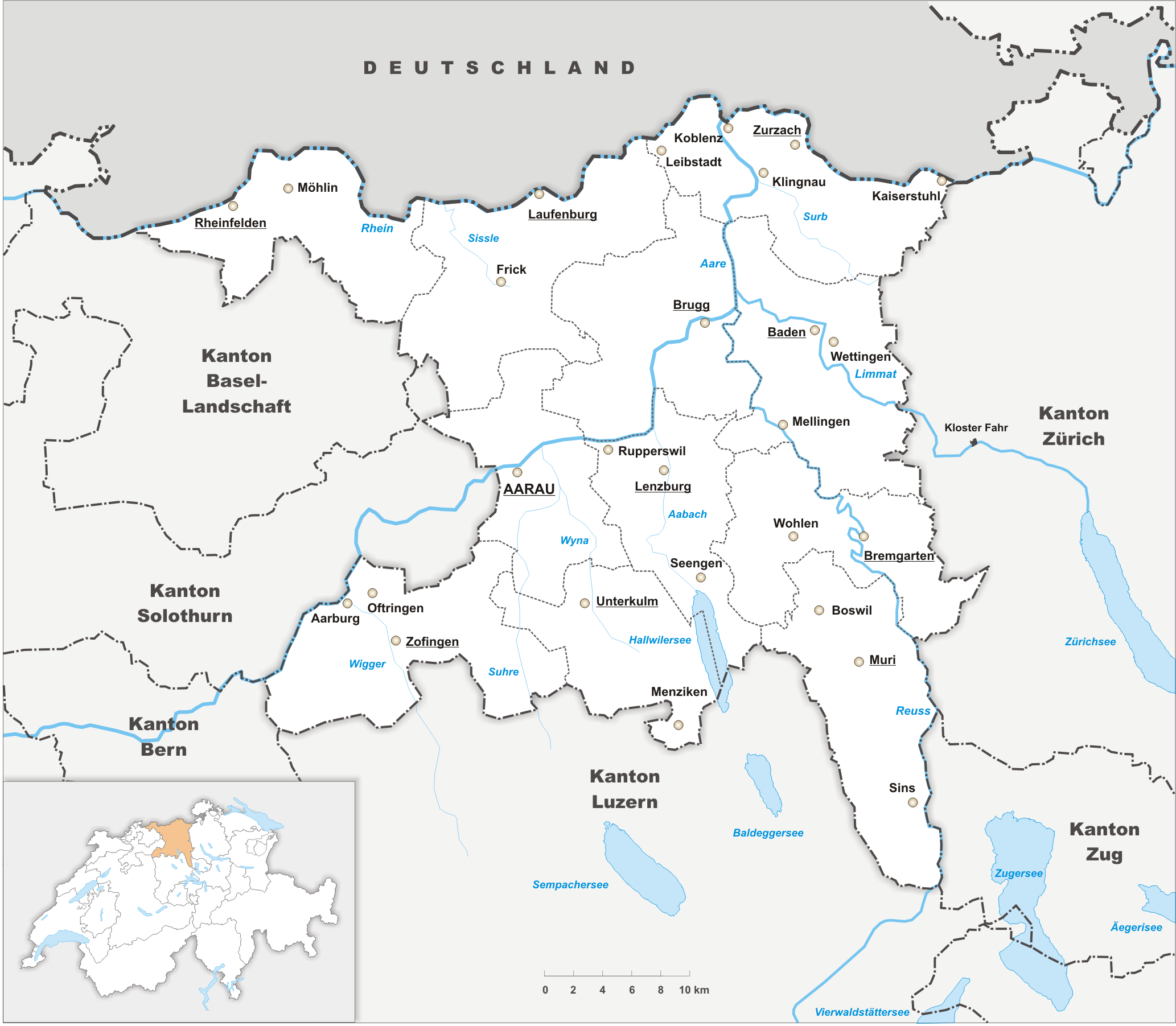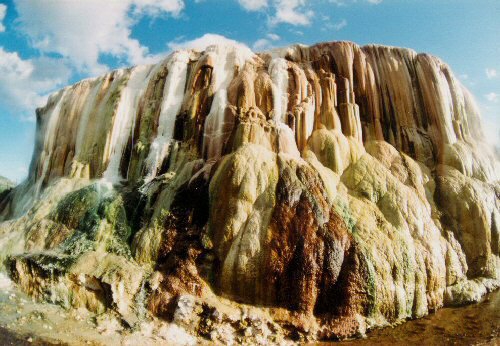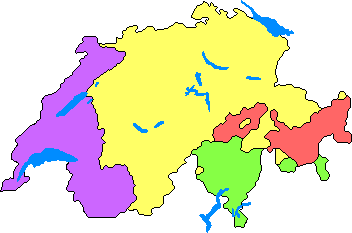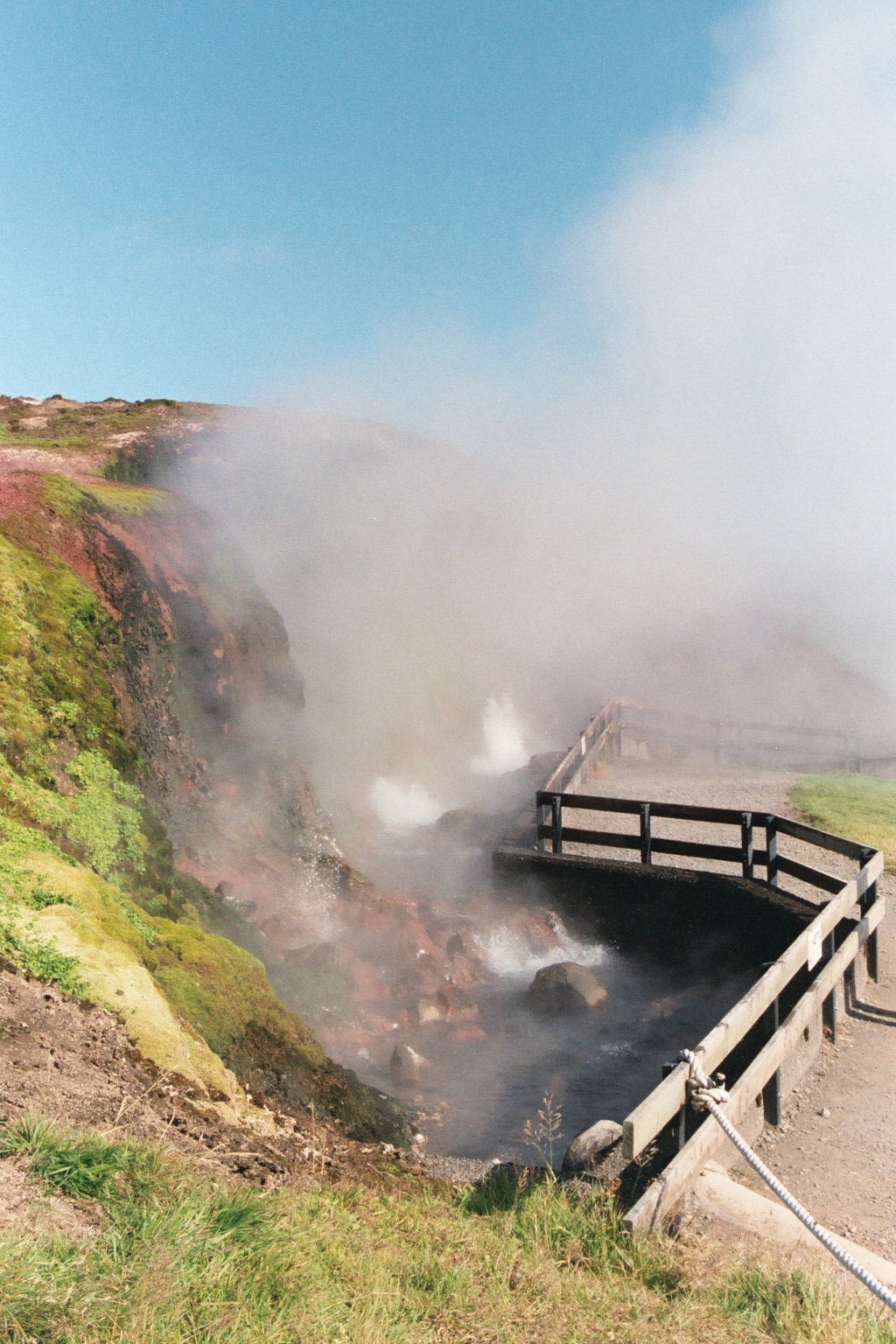|
Baden AG
Baden (German for " baths"), sometimes unofficially, to distinguish it from other Badens, called Baden bei Zürich ("Baden near Zürich") or Baden im Aargau ("Baden in the Aargau"), is a town and a municipality in Switzerland. It is the main town or seat of the district of Baden in the canton of Aargau. Located northwest of Zürich in the Limmat Valley () mainly on the western side of the river Limmat, its mineral hot springs have been famed since at least the Roman era. Its official language is (the Swiss variety of Standard) German, but the main spoken language is the local Alemannic Swiss-German dialect. the town had a population of over 19,000. Geography Downtown Baden is located on the left bank of the river Limmat in its eponymous valley. Its area is divided into the Kappelerhof, Allmend, Meierhof, and Chrüzliberg. In 1962, Baden also absorbed the adjacent village of Dättwil. On the right bank of the river is the village of Ennetbaden, formerly "Little Baden" (') ... [...More Info...] [...Related Items...] OR: [Wikipedia] [Google] [Baidu] |
Baden (district, Aargau)
Baden District is a district in the canton of Aargau, Switzerland. The district capital is the town of Baden, Switzerland, Baden and the largest municipality is Wettingen, located in the Limmat Valley (German: ''Limmattal''). The district has a total of 25 municipalities, an area of , and a population () of about 138,000. Geography Baden District has an area, , of . Of this area, 37.1% is used for agricultural purposes, while 38.5% is forested. The rest of the land, (22.4%) is settled. History The district is descended from the historic County of Baden, which was dissolved in 1798 upon the creation of the short-lived Canton of Baden (1798–1803). The first district of Baden existed during the existence of that canton, covering part of the former county, and upon its merging into the canton of Aargau, the contemporary district was formed. Upon the merging of the canton of Baden into Aargau in 1803, the district gained the municipalities of Würenlingen, Bellikon, Künten, Remets ... [...More Info...] [...Related Items...] OR: [Wikipedia] [Google] [Baidu] |
Aargau
Aargau ( ; ), more formally the Canton of Aargau (; ; ; ), is one of the Canton of Switzerland, 26 cantons forming the Switzerland, Swiss Confederation. It is composed of eleven districts and its capital is Aarau. Aargau is one of the most northerly cantons of Switzerland, by the lower course of the Aare River, which is why it is called ''Aar-Gau (country subdivision), gau'' ("Aare province"). It is one of the most densely populated regions of Switzerland. History Early history The area of Aargau and the surrounding areas were controlled by the Helvetians, a tribe of Celts, as far back as 200 BC. It was eventually occupied by the Roman Empire, Romans and then by the 6th century, the Franks. The Romans built a major settlement called Vindonissa, near the present location of Brugg. Medieval Aargau The reconstructed Old High German name of Aargau is ''Argowe'', first unambiguously attested (in the spelling ''Argue'') in 795. The term described a territory only loosely eq ... [...More Info...] [...Related Items...] OR: [Wikipedia] [Google] [Baidu] |
Roman Empire
The Roman Empire ruled the Mediterranean and much of Europe, Western Asia and North Africa. The Roman people, Romans conquered most of this during the Roman Republic, Republic, and it was ruled by emperors following Octavian's assumption of effective sole rule in 27 BC. The Western Roman Empire, western empire collapsed in 476 AD, but the Byzantine Empire, eastern empire lasted until the fall of Constantinople in 1453. By 100 BC, the city of Rome had expanded its rule from the Italian peninsula to most of the Mediterranean Sea, Mediterranean and beyond. However, it was severely destabilised by List of Roman civil wars and revolts, civil wars and political conflicts, which culminated in the Wars of Augustus, victory of Octavian over Mark Antony and Cleopatra at the Battle of Actium in 31 BC, and the subsequent conquest of the Ptolemaic Kingdom in Egypt. In 27 BC, the Roman Senate granted Octavian overarching military power () and the new title of ''Augustus (title), Augustus'' ... [...More Info...] [...Related Items...] OR: [Wikipedia] [Google] [Baidu] |
Wettingen Isistempel
Wettingen is a residential community in the district of Baden (district, Aargau), Baden in the Swiss canton of Aargau. With a population about 20,000, Wettingen is the second-largest municipality in the canton. Geography Wettingen is located on the right bank of the Limmat, located in the Limmat Valley (German: ''Limmattal''), before the deep valley in Baden. Most of the town is located on the Wettingerfeld (Wettinger Field), which is a flat plain surrounded on all sides by natural borders: to the south and west by the Limmat, to the north by the steep southern slope of the Lägern, and to the East by the Sulperg (). A vineyard is located on a section of the Lägern’s slope. Between the Lägern and the Sulperg is the undeveloped Eigital (Eigi valley). At the Eigital’s west end, in the northeastern section of the Wettingerfeld, is the relatively well-maintained old village center. A small creek flows through the Wettingerfeld and empties into the Limmat at the ''Gottesgraben' ... [...More Info...] [...Related Items...] OR: [Wikipedia] [Google] [Baidu] |
Sulfur Springs
Mineral springs are naturally occurring springs that produce hard water, water that contains dissolved minerals. Salts, sulfur compounds, and gases are among the substances that can be dissolved in the spring water during its passage underground. In this they are unlike sweet springs, which produce soft water with no noticeable dissolved gasses. The dissolved minerals may alter the water's taste. Mineral water obtained from mineral springs, and the precipitated salts such as Epsom salt have long been important commercial products. Some mineral springs may contain significant amounts of harmful dissolved minerals, such as arsenic, and should not be drunk. Sulfur springs smell of rotten eggs due to hydrogen sulfide (H2S), which is hazardous and sometimes deadly. It is a gas, and it usually enters the body when it is breathed in. The quantities ingested in drinking water are much lower and are not considered likely to cause harm, but few studies on long-term, low-level expos ... [...More Info...] [...Related Items...] OR: [Wikipedia] [Google] [Baidu] |
Hot Springs
A hot spring, hydrothermal spring, or geothermal spring is a Spring (hydrology), spring produced by the emergence of Geothermal activity, geothermally heated groundwater onto the surface of the Earth. The groundwater is heated either by shallow bodies of magma (molten rock) or by circulation through fault (geology), faults to hot rock deep in the Earth's crust. Hot spring water often contains large amounts of dissolved minerals. The chemistry of hot springs ranges from acid sulfate springs with a pH as low as 0.8, to alkaline chloride springs saturated with silica, to bicarbonate springs saturated with carbon dioxide and carbonate minerals. Some springs also contain abundant dissolved iron. The minerals brought to the surface in hot springs often feed communities of extremophiles, microorganisms adapted to extreme conditions, and it is possible that life on Earth had its origin in hot springs. Humans have made use of hot springs for bathing, relaxation, or medical therapy for th ... [...More Info...] [...Related Items...] OR: [Wikipedia] [Google] [Baidu] |
Baden Altstadt 9502
Baden (; ) is a historical territory in southern Germany. In earlier times it was considered to be on both sides of the Upper Rhine, but since the Napoleonic Wars, it has been considered only East of the Rhine. History The margraves of Baden originated from the House of Zähringen. Baden is named after the margraves' residence, Hohenbaden Castle in Baden-Baden. Hermann II of Baden first claimed the title of Margrave of Baden in 1112. A united Margraviate of Baden existed from this time until 1535, when it was split into the two Margraviates of Baden-Durlach and Baden-Baden. Following a devastating fire in Baden-Baden in 1689, the capital was moved to Rastatt. The two parts were reunited in 1771 under Margrave Charles Frederick. The restored Margraviate with its capital Karlsruhe was elevated to the status of electorate in 1803. In 1806, the Electorate of Baden, receiving territorial additions, became the Grand Duchy of Baden. The Grand Duchy of Baden was a state within t ... [...More Info...] [...Related Items...] OR: [Wikipedia] [Google] [Baidu] |
Swiss German (linguistics)
Swiss German (Standard German: , ,Because of the many different dialects, and because there is no #Conventions, defined orthography for any of them, many different spellings can be found. and others; ) is any of the Alemannic German, Alemannic dialects spoken in the German-speaking Switzerland, German-speaking part of Switzerland, and in some Alps, Alpine communities in Northern Italy bordering Switzerland. Occasionally, the Alemannic dialects spoken in other countries are grouped together with Swiss German as well, especially the dialects of Liechtenstein and Austrian Vorarlberg, which are closely associated to Switzerland's. Linguistically, Alemannic is divided into Low Alemannic German, Low, High Alemannic German, High and Highest Alemannic German, Highest Alemannic, varieties all of which are spoken both inside and outside Switzerland. The only exception within German-speaking Switzerland is the municipality of Samnaun, where a Bavarian language, Bavarian dialect is spoken. ... [...More Info...] [...Related Items...] OR: [Wikipedia] [Google] [Baidu] |
Alemannic German
Alemannic, or rarely Alemannish (''Alemannisch'', ), is a group of High German dialects. The name derives from the ancient Germanic tribal confederation known as the Alemanni ("all men"). Distribution Alemannic dialects are spoken by approximately ten million people in several countries: * In Europe: ** Switzerland: all German-speaking parts of the country except Samnaun ** Germany: centre and south of Baden-Württemberg, Swabia, and certain districts of Bavaria ** Austria: Vorarlberg, Reutte District of Tyrol ** Liechtenstein ** France: Alsace region ( Alsatian dialect) and in some villages of the Phalsbourg county, in Lorraine ** Italy: Gressoney-La-Trinité, Gressoney-Saint-Jean, Issime, Alagna Valsesia, Rimella and Formazza, in some other villages almost extinct *Outside Europe: ** United States: Allen and Adams County, Indiana, by the Amish there and also in their daughter settlements in Indiana and other U.S. states. ** Venezuela: Colonia Tovar ( Colonia ... [...More Info...] [...Related Items...] OR: [Wikipedia] [Google] [Baidu] |
Swiss Standard German
Swiss Standard German (SSG; ), or Swiss High German ( or ; ), referred to by the Swiss as , or , is the written form of one (German language, German) of four languages of Switzerland, national languages in Switzerland, besides French language, French, Italian language, Italian, and Romansh language, Romansh. It is a variety of Standard German, used in the German-speaking Switzerland, German-speaking part of Switzerland and in Liechtenstein. It is mainly written and rather less often spoken. Swiss Standard German differs from Swiss German, an umbrella term for the various Alemannic German dialects (in the sense of "traditional regional varieties") that are the default everyday languages in German-speaking Switzerland. Standard German is a pluricentric language. In contrast with other local Variety (linguistics), varieties of Standard German, Swiss Standard German has distinctive features in all linguistic domains: not only in phonology, but also in vocabulary, syntax, morphology ( ... [...More Info...] [...Related Items...] OR: [Wikipedia] [Google] [Baidu] |
Switzerland In The Roman Era
The territory of modern Switzerland was a part of the Roman Republic and Empire An empire is a political unit made up of several territories, military outpost (military), outposts, and peoples, "usually created by conquest, and divided between a hegemony, dominant center and subordinate peripheries". The center of the ... for a period of about six centuries, beginning with the step-by-step conquest of the area by Roman armies from the 2nd century BC and ending with the Fall of the Western Roman Empire in the 5th century AD. The mostly Celts, Celtic tribes of the area were subjugated by successive Roman campaigns aimed at control of the strategic routes from Italy across the Alps to the Rhine and into Gaul, most importantly by Julius Caesar's defeat of the largest tribal group, the Helvetii, in the Gallic Wars in 58 BC. Under the ''Pax Romana'', the area was smoothly integrated into the prospering Empire, and its population Romanization (cultural), assimilated into ... [...More Info...] [...Related Items...] OR: [Wikipedia] [Google] [Baidu] |
Mineral Hot Spring
A hot spring, hydrothermal spring, or geothermal spring is a spring produced by the emergence of geothermally heated groundwater onto the surface of the Earth. The groundwater is heated either by shallow bodies of magma (molten rock) or by circulation through faults to hot rock deep in the Earth's crust. Hot spring water often contains large amounts of dissolved minerals. The chemistry of hot springs ranges from acid sulfate springs with a pH as low as 0.8, to alkaline chloride springs saturated with silica, to bicarbonate springs saturated with carbon dioxide and carbonate minerals. Some springs also contain abundant dissolved iron. The minerals brought to the surface in hot springs often feed communities of extremophiles, microorganisms adapted to extreme conditions, and it is possible that life on Earth had its origin in hot springs. Humans have made use of hot springs for bathing, relaxation, or medical therapy for thousands of years. However, some are hot enough that im ... [...More Info...] [...Related Items...] OR: [Wikipedia] [Google] [Baidu] |








